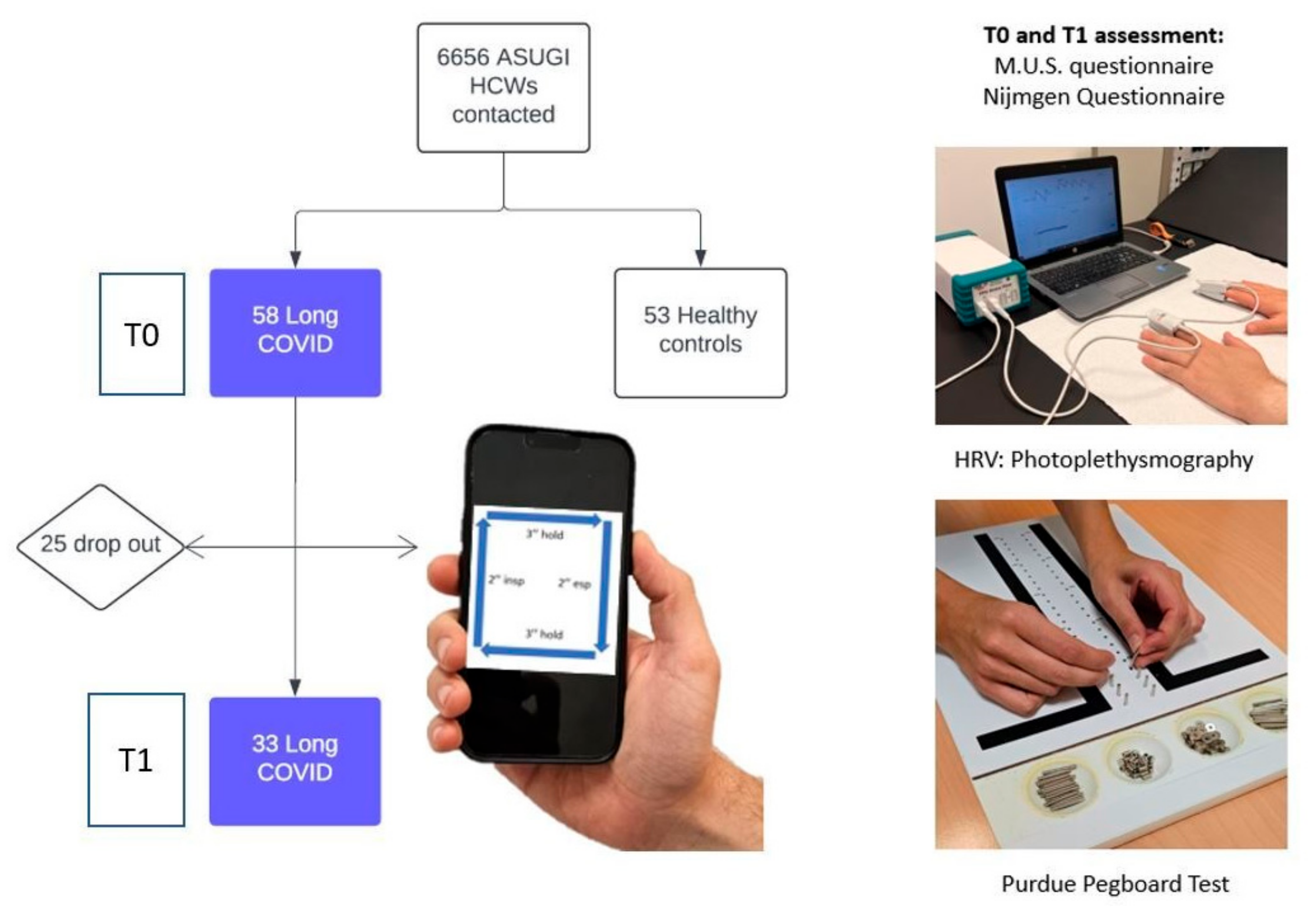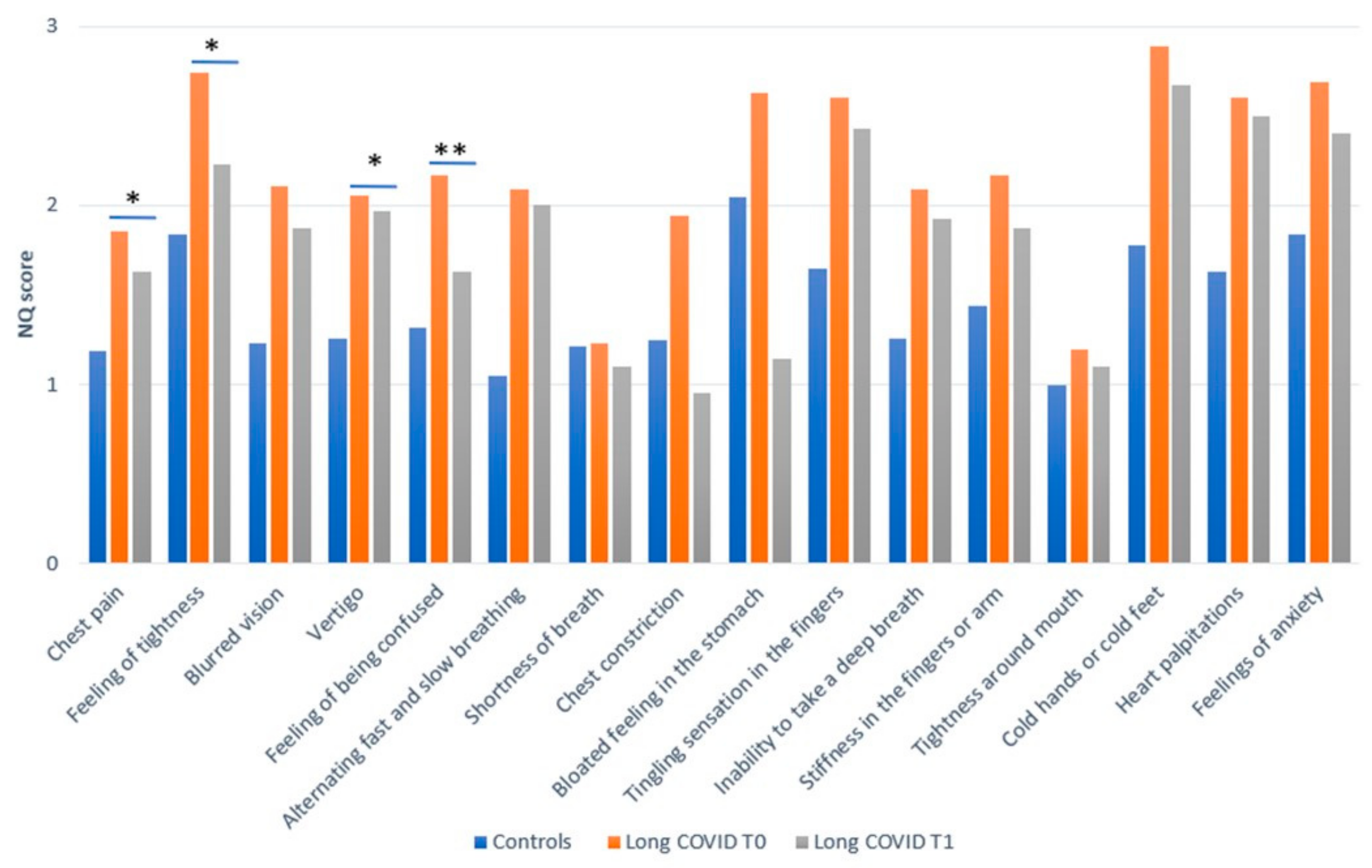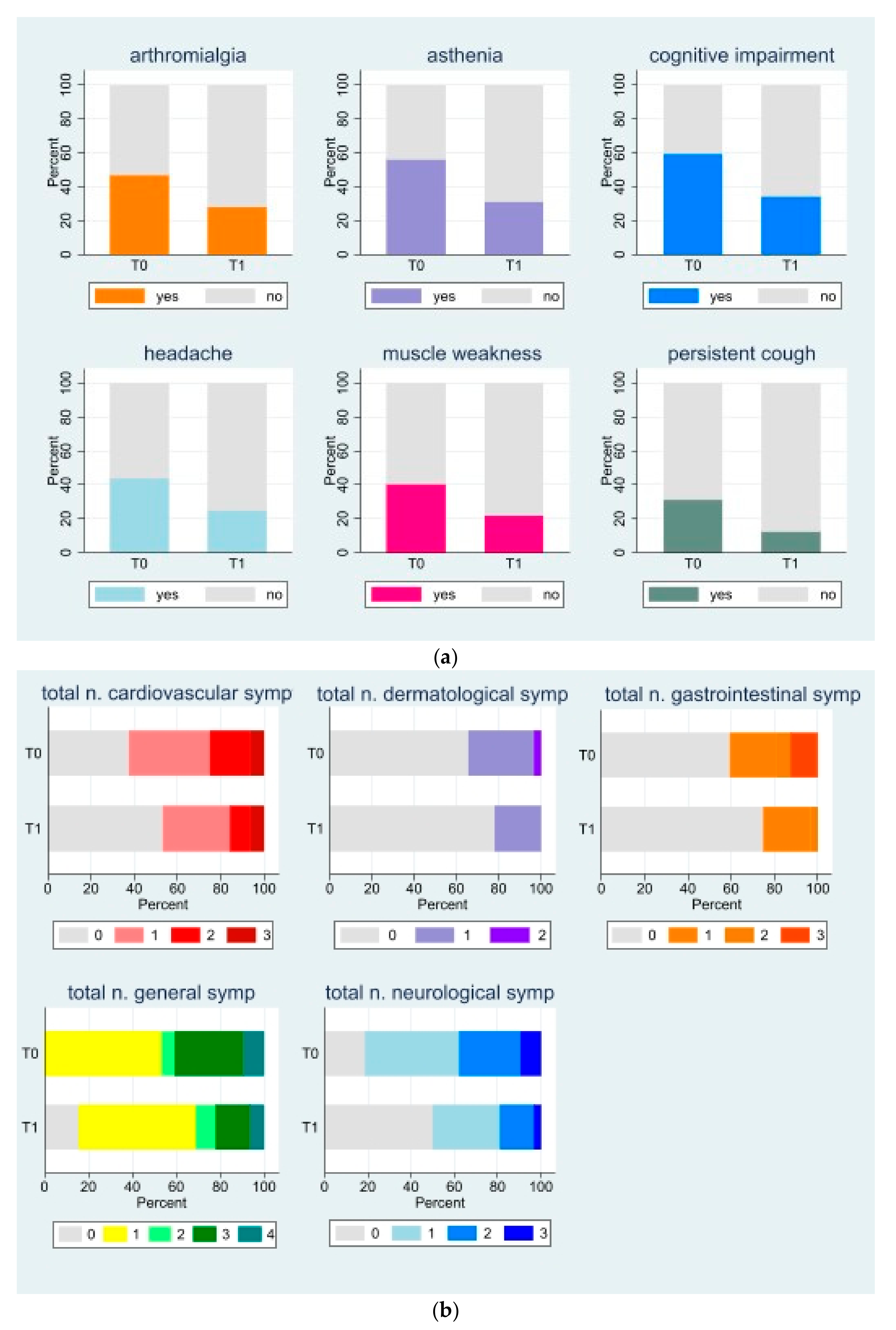Slow-Paced Breathing Intervention in Healthcare Workers Affected by Long COVID: Effects on Systemic and Dysfunctional Breathing Symptoms, Manual Dexterity and HRV
Abstract
:1. Introduction
2. Materials and Methods
2.1. Study Design and Ethical Aspects
2.2. Participants Enrolment
2.3. Data Collection
- General health and long-COVID symptom questionnaires: Data on age, sex, weight and height, smoking habits, SARS-Cov-2 vaccination status, comorbidities, pharmacotherapy and job descriptors were collected. The symptoms of long-COVID were assessed according to the ones described by the Istituto Superiore di Sanità. [32].
- Psychosomatic symptoms using the M.U.S. and Distress questionnaires related to autonomic impairment: This tool allows the investigation of “medically unexplained symptoms”. It consists of 39 items exploring the physical, psychological, cognitive and emotional domains. Having more than 6 of these symptoms has been associated with low heart rate variability (RMSSD and SDNN values) and an impaired autonomic nervous system [33,34]. Each item can be rated by the patient on a scale from 0 (no symptom) to 10 (highest intensity). The final score is calculated by the sum of the intensity of each item.
- Dysfunctional breathing symptoms through Nijmegen questionnaire (NQ): Dyspnoea has been described as a common symptom in long-COVID subjects, but it may derive from multiple causes, among which psychological ones may also play a role. This tool is composed of 16 items, each of which can be scored from 0 to 4 by the participant. It has been used to assess dysfunctional breathing patterns [35].
- Manual dexterity assessment through Purdue Pegboard test manual dexterity (PPT): After instructions, a short demonstration was delivered to the subject. Subsequently, each participant had the possibility to have a trial before the administration of the evaluated test. The procedure comprises a series of steps that must be carried out in a specific order. The subject must pick up pins placed in a bowl on the corresponding side of the tested hand and try to place as many pins as possible in the prepared holes within 30 s. The task is carried out first with the dominant hand, then with the non-dominant hand, and finally, with both hands at once (three separate tasks). The assembly test is then performed, which is composed of a standardised sequence of assembly of pegs, washers and collars with both hands in one minute. The total score is then calculated adding the 1 to 4 task scores together [36,37].
- Cardiovascular autonomic function assessment through photoplethysmography (PPG Stress Flow®, BioTekna Co, Italy): This device allows the detection of the digital pulse waves produced by the systolic contractile force of the heart. After 20 min of acclimatisation to the experimental environment (room temperature 22–24 °C; relative humidity 40–60%) while the subjects are seated in a comfortable chair with their forearms resting on the table, the procedure starts. An infrared probe is placed on the II finger of both hands separately, and the acquired optical signal is then processed by means of appropriate algorithms in order to derive the ECG signal. The detailed procedure has been described elsewhere [38]. The equipment used for the study has been authorised by the Italian Ministry of Health (CND Z12040113). Patients underwent the study protocol in the morning. Measurements were taken for 5 min during spontaneous breathing and then for 5 min during slow breathing (6 breaths/min, i.e., 0.1 Hz).
- Slow-paced breathing protocol: Each long-COVID participant was taught how to perform resonant slow-paced breathing (SPB) during the initial inpatient assessment, a manoeuvre which elicits a cardiovagal modulation. The breathing cycle was the same for all participants and was composed of 2 s. inspiration, 3 s. holding, 2 s. expiration, and 3 s pause (6 breath per minute, i.e., 0.1 Hz), repeated over a 5 min period. This breath frequency is acknowledged to be capable of maximising the temporal coherence between blood pressure, respiratory and cardiac phases, leading to higher cardiac oscillations, which in turn deliver the central and peripherical benefits [30]. The cases were then instructed to perform it three times a day (morning, early afternoon and before bedtime) for one month using a mobile video tutorial. The researchers contacted them once a week to check that they were following the instructions. Figure 1 shows the flowchart of the study.
2.4. Statystical Analysis
3. Results
4. Discussion
5. Conclusions
Supplementary Materials
Author Contributions
Funding
Institutional Review Board Statement
Informed Consent Statement
Data Availability Statement
Acknowledgments
Conflicts of Interest
References
- WHO Europe. Available online: https://www.who.int/europe/news-room/fact-sheets/item/post-covid-19-condition (accessed on 30 October 2023).
- Chen, C.; Haupert, S.R.; Zimmermann, L.; Shi, X.; Fritsche, L.G.; Mukherjee, B. Global Prevalence of Post-Coronavirus Disease 2019 (COVID-19) Condition or Long COVID: A Meta-Analysis and Systematic Review. J. Infect. Dis. 2022, 226, 1593–1607. [Google Scholar] [CrossRef] [PubMed]
- Efstathiou, V.; Stefanou, M.I.; Demetriou, M.; Siafakas, N.; Makris, M.; Tsivgoulis, G.; Zoumpourlis, V.; Kympouropoulos, S.P.; Tsoporis, J.N.; Spandidos, D.A.; et al. Long COVID and neuropsychiatric manifestations (Review). Exp. Ther. Med. 2022, 23, 363. [Google Scholar] [CrossRef] [PubMed] [PubMed Central]
- Schou, T.M.; Joca, S.; Wegener, G.; Bay-Richter, C. Psychiatric and neuropsychiatric sequelae of COVID-19-A systematic review. Brain Behav. Immun. 2021, 97, 328–348. [Google Scholar] [CrossRef]
- Mendola, M.; Leoni, M.; Cozzi, Y.; Manzari, A.; Tonelli, F.; Metruccio, F.; Tosti, L.; Battini, V.; Cucchi, I.; Costa, M.C.; et al. Long-term COVID symptoms, work ability and fitness to work in healthcare workers hospitalized for Sars-CoV-2 infection. Med. Lav. 2022, 113, e2022040. [Google Scholar] [CrossRef]
- Cegolon, L.; Mauro, M.; Sansone, D.; Tassinari, A.; Gobba, F.M.; Modenese, A.; Casolari, L.; Liviero, F.; Pavanello, S.; Scapellato, M.L.; et al. A Multi-Center Study Investigating Long COVID-19 in Healthcare Workers from North-Eastern Italy: Prevalence, Risk Factors and the Impact of Pre-Existing Humoral Immunity-ORCHESTRA Project. Vaccines 2023, 11, 1769. [Google Scholar] [CrossRef] [PubMed] [PubMed Central]
- Chee, Y.J.; Fan, B.E.; Young, B.E.; Dalan, R.; Lye, D.C. Clinical trials on the pharmacological treatment of long COVID: A systematic review. J. Med. Virol. 2023, 95, e28289. [Google Scholar] [CrossRef] [PubMed] [PubMed Central]
- Chandan, J.S.; Brown, K.R.; Simms-Williams, N.; Bashir, N.Z.; Camaradou, J.; Heining, D.; Turner, G.M.; Rivera, S.C.; Hotham, R.; Minhas, S.; et al. Non-Pharmacological Therapies for Post-Viral Syndromes, Including Long COVID: A Systematic Review. Int. J. Environ. Res. Public Health 2023, 20, 3477. [Google Scholar] [CrossRef] [PubMed] [PubMed Central]
- Ledford, H. Long-COVID treatments: Why the world is still waiting. Nature 2022, 608, 258–260. [Google Scholar] [CrossRef] [PubMed]
- Motilal, S.; Rampersad, R.; Adams, M.; Goon Lun, S.; Ramdhanie, A.; Ruiz, T.; Shah, A.; Wilkinson, A.; Lewis, J. Randomized Controlled Trials for Post-COVID-19 Conditions: A Systematic Review. Cureus 2024, 16, e67603. [Google Scholar] [CrossRef] [PubMed] [PubMed Central]
- Dani, M.; Dirksen, A.; Taraborrelli, P.; Torocastro, M.; Panagopoulos, D.; Sutton, R.; Lim, P.B. Autonomic dysfunction in ‘long COVID’: Rationale, physiology and management strategies. Clin. Med. 2021, 21, e63–e67. [Google Scholar] [CrossRef] [PubMed] [PubMed Central]
- Shouman, K.; Vanichkachorn, G.; Cheshire, W.P.; Suarez, M.D.; Shelly, S.; Lamotte, G.J.; Sandroni, P.; Benarroch, E.E.; Berini, S.E.; Cutsforth-Gregory, J.K.; et al. Autonomic dysfunction following COVID-19 infection: An early experience. Clin. Auton. Res. 2021, 31, 385–394. [Google Scholar] [CrossRef] [PubMed]
- DePace, N.L.; Colombo, J. Long-COVID Syndrome and the Cardiovascular System: A Review of Neurocardiologic Effects on Multiple Systems. Curr. Cardiol. Rep. 2022, 24, 1711–1726. [Google Scholar] [CrossRef] [PubMed] [PubMed Central]
- Zanin, A.; Amah, G.; Chakroun, S.; Testard, P.; Faucher, A.; Le, T.Y.V.; Slama, D.; Le Baut, V.; Lozeron, P.; Salmon, D.; et al. Parasympathetic autonomic dysfunction is more often evidenced than sympathetic autonomic dysfunction in fluctuating and polymorphic symptoms of “long-COVID” patients. Sci. Rep. 2023, 13, 8251. [Google Scholar] [CrossRef] [PubMed] [PubMed Central]
- Marques, K.C.; Quaresma, J.A.S.; Falcão, L.F.M. Cardiovascular autonomic dysfunction in “Long COVID”: Pathophysiology, heart rate variability, and inflammatory markers. Front. Cardiovasc. Med. 2023, 10, 1256512. [Google Scholar] [CrossRef] [PubMed] [PubMed Central]
- Benarroch, E.E. The central autonomic network: Functional organization, dysfunction and perspective. Mayo Clin. Proc. 1993, 68, 988–1001. [Google Scholar] [CrossRef]
- Hugon, J.; Queneau, M.; Sanchez Ortiz, M.; Msika, E.F.; Farid, K.; Paquet, C. Cognitive decline and brainstem hypometabolism in long COVID: A case series. Brain Behav. 2022, 12, e2513. [Google Scholar] [CrossRef]
- Guedj, E.; Campion, J.Y.; Dudouet, P.; Kaphan, E.; Bregeon, F.; Tissot-Dupont, H.; Guis, S.; Barthelemy, F.; Habert, P.; Ceccaldi, M.; et al. 18F-FDG brain PET hypometabolism in patients with long COVID. Eur. J. Nucl. Med. Mol. Imaging 2021, 48, 2823–2833. [Google Scholar] [CrossRef]
- Velichkovsky, B.B.; Razvaliaeva, A.Y.; Khlebnikova, A.A.; Manukyan, P.A.; Kasatkin, V.N.; Barmin, A.V. Systematic Review and Meta-Analysis of Clinically Relevant Executive Functions Tests Performance after COVID-19. Behav. Neurol. 2023, 2023, 1094267. [Google Scholar] [CrossRef] [PubMed] [PubMed Central]
- Rosas-Ballina, M.; Tracey, K.J. Cholinergic control of inflammation. J. Intern. Med. 2009, 265, 663–679. [Google Scholar] [CrossRef] [PubMed] [PubMed Central]
- Giunta, S.; Giordani, C.; De Luca, M.; Olivieri, F. Long-COVID-19 autonomic dysfunction: An integrated view in the framework of inflammaging. Mech. Ageing Dev. 2024, 218, 111915. [Google Scholar] [CrossRef] [PubMed]
- Azabou, E.; Bao, G.; Bounab, R.; Heming, N.; Annane, D. Vagus Nerve Stimulation: A Potential Adjunct Therapy for COVID-19. Front. Med. 2021, 8, 625836. [Google Scholar] [CrossRef] [PubMed] [PubMed Central]
- Linnhoff, S.; Koehler, L.; Haghikia, A.; Zaehle, T. The therapeutic potential of non-invasive brain stimulation for the treatment of Long-COVID-related cognitive fatigue. Front. Immunol. 2023, 13, 935614. [Google Scholar] [CrossRef] [PubMed] [PubMed Central]
- Badran, B.W.; Huffman, S.M.; Dancy, M.; Austelle, C.W.; Bikson, M.; Kautz, S.A.; George, M.S. A pilot randomized controlled trial of supervised, at-home, self-administered transcutaneous auricular vagus nerve stimulation (taVNS) to manage long COVID symptoms. Bioelectron. Med. 2022, 8, 13. [Google Scholar] [CrossRef] [PubMed] [PubMed Central]
- Zheng, Z.S.; Simonian, N.; Wang, J.; Rosario, E.R. Transcutaneous vagus nerve stimulation improves Long COVID symptoms in a female cohort: A pilot study. Front. Neurol. 2024, 15, 1393371. [Google Scholar] [CrossRef] [PubMed] [PubMed Central]
- Thayer, J.F.; Lane, R.D. A model of neurovisceral integration in emotion regulation and dysregulation. J. Affect. Disord. 2000, 61, 201–216. [Google Scholar] [CrossRef] [PubMed]
- Thayer, J.F.; Loerbroks, A.; Sternberg, E.M. Inflammation and cardiorespiratory control: The role of the vagus nerve. Respir. Physiol. Neurobiol. 2011, 178, 387–394. [Google Scholar] [CrossRef] [PubMed]
- Smith, R.; Thayer, J.F.; Khalsa, S.S.; Lane, R.D. The hierarchical basis of neurovisceral integration. Neurosci. Biobehav. Rev. 2017, 75, 274–296. [Google Scholar] [CrossRef] [PubMed]
- Gerritsen, R.J.S.; Band, G.P.H. Breath of Life: The Respiratory Vagal Stimulation Model of Contemplative Activity. Front. Hum. Neurosci. 2018, 12, 397. [Google Scholar] [CrossRef] [PubMed] [PubMed Central]
- Sevoz-Couche, C.; Laborde, S. Heart rate variability and slow-paced breathing:when coherence meets resonance. Neurosci. Biobehav. Rev. 2022, 135, 104576. [Google Scholar] [CrossRef] [PubMed]
- Colzato, L.; Beste, C. A literature review on the neurophysiological underpinnings and cognitive effects of transcutaneous vagus nerve stimulation: Challenges and future directions. J. Neurophysiol. 2020, 123, 1739–1755. [Google Scholar] [CrossRef] [PubMed]
- Istituto Superiore di Sanità. Special on CoViD-19 Long-CoViD Symptoms. Available online: https://www.iss.it/en/long-covid-sintomi (accessed on 30 October 2022).
- Chrousos, G.P.; Papadopoulou-Marketou, N.; Bacopoulou, F.; Lucafò, M.; Gallotta, A.; Boschiero, D. Photoplethysmography (PPG)-determined heart rate variability (HRV) and extracellular water (ECW) in the evaluation of chronic stress and in-flammation. Hormones 2022, 21, 383–390. [Google Scholar] [CrossRef] [PubMed]
- Chrousos, G.P.; Boschiero, D. Clinical validation of a non-invasive electrodermal biofeedback device useful for reducing chronic perceived pain and systemic inflammation. Hormones 2019, 18, 207–213. [Google Scholar] [CrossRef] [PubMed] [PubMed Central]
- van Dixhoorn, J.; Folgering, H. The Nijmegen Questionnaire and dysfunctional breathing. ERJ Open Res. 2015, 1, 00001–02015. [Google Scholar] [CrossRef] [PubMed] [PubMed Central]
- Tiffin, J.; Asher, E.J. The Purdue pegboard; norms and studies of reliability and validity. J. Appl. Psychol. 1948, 32, 234–247. [Google Scholar] [CrossRef] [PubMed]
- Mauro, M.; Bestiaco, N.; Zulian, E.; Markežič, M.M.; Bignolin, I.; Sirianni, F.; Larese Filon, F. Manual Dexterity, Tactile Perception and Inflammatory Profile in Hcws Affected by Long Covid: A Case—Control Study. Available online: https://ssrn.com/abstract=4889166 (accessed on 15 September 2024).
- Mauro, M.; Cegolon, L.; Bestiaco, N.; Zulian, E.; Larese Filon, F. Heart Rate Variability Modulation Through Slow-Paced Breathing in Health Care Workers with Long COVID: A Case-Control Study. Am. J. Med. 2024, in press. [CrossRef] [PubMed]
- Corrado, J.; Iftekhar, N.; Halpin, S.; Li, M.; Tarrant, R.; Grimaldi, J.; Simms, A.; O’Connor, R.J.; Casson, A.; Sivan, M. HEART Rate Variability Biofeedback for LOng COVID Dysautonomia (HEARTLOC): Results of a Feasibility Study. Adv. Rehabil. Sci. Pract. 2024, 13, 27536351241227261. [Google Scholar] [CrossRef] [PubMed] [PubMed Central]
- Polizzi, J.; Tosto-Mancuso, J.; Tabacof, L.; Wood, J.; Putrino, D. Resonant breathing improves self-reported symptoms and wellbeing in people with Long COVID. Front. Rehabil. Sci. 2024, 5, 1411344. [Google Scholar] [CrossRef] [PubMed] [PubMed Central]
- Fournié, C.; Chouchou, F.; Dalleau, G.; Caderby, T.; Cabrera, Q.; Verkindt, C. Heart rate variability biofeedback in chronic disease management: A systematic review. Complement. Ther. Med. 2021, 60, 102750. [Google Scholar] [CrossRef] [PubMed]
- Laborde, S.; Allen, M.S.; Borges, U.; Dosseville, F.; Hosang, T.J.; Iskra, M.; Mosley, E.; Salvotti, C.; Spolverato, L.; Zammit, N.; et al. Effects of voluntary slow breathing on heart rate and heart rate variability: A systematic review and a meta-analysis. Neurosci. Biobehav. Rev. 2022, 138, 104711. [Google Scholar] [CrossRef] [PubMed]
- Sanal-Hayes, N.E.M.; Hayes, L.D.; Mclaughlin, M.; Berry, E.C.J.; Sculthorpe, N.F. People with Long COVID and ME/CFS Exhibit Similarly Impaired Dexterity and Bimanual Coordination: A Case-Case-Control Study. Am. J. Med. 2024. [Google Scholar] [CrossRef] [PubMed]
- Diamond, A. Activities and Programs That Improve Children’s Executive Functions. Curr. Dir. Psychol. Sci. 2012, 21, 335–341. [Google Scholar] [CrossRef] [PubMed] [PubMed Central]
- Foley, J.O.; DuBois, F.S. Quantitative studies of the vagus nerve in the cat: I. The ratio of sensory to motor fibers. J. Nerv. Ment. Dis. 1937, 86, 587. [Google Scholar] [CrossRef]



Disclaimer/Publisher’s Note: The statements, opinions and data contained in all publications are solely those of the individual author(s) and contributor(s) and not of MDPI and/or the editor(s). MDPI and/or the editor(s) disclaim responsibility for any injury to people or property resulting from any ideas, methods, instructions or products referred to in the content. |
© 2024 by the authors. Licensee MDPI, Basel, Switzerland. This article is an open access article distributed under the terms and conditions of the Creative Commons Attribution (CC BY) license (https://creativecommons.org/licenses/by/4.0/).
Share and Cite
Mauro, M.; Zulian, E.; Bestiaco, N.; Polano, M.; Larese Filon, F. Slow-Paced Breathing Intervention in Healthcare Workers Affected by Long COVID: Effects on Systemic and Dysfunctional Breathing Symptoms, Manual Dexterity and HRV. Biomedicines 2024, 12, 2254. https://doi.org/10.3390/biomedicines12102254
Mauro M, Zulian E, Bestiaco N, Polano M, Larese Filon F. Slow-Paced Breathing Intervention in Healthcare Workers Affected by Long COVID: Effects on Systemic and Dysfunctional Breathing Symptoms, Manual Dexterity and HRV. Biomedicines. 2024; 12(10):2254. https://doi.org/10.3390/biomedicines12102254
Chicago/Turabian StyleMauro, Marcella, Elisa Zulian, Nicoletta Bestiaco, Maurizio Polano, and Francesca Larese Filon. 2024. "Slow-Paced Breathing Intervention in Healthcare Workers Affected by Long COVID: Effects on Systemic and Dysfunctional Breathing Symptoms, Manual Dexterity and HRV" Biomedicines 12, no. 10: 2254. https://doi.org/10.3390/biomedicines12102254
APA StyleMauro, M., Zulian, E., Bestiaco, N., Polano, M., & Larese Filon, F. (2024). Slow-Paced Breathing Intervention in Healthcare Workers Affected by Long COVID: Effects on Systemic and Dysfunctional Breathing Symptoms, Manual Dexterity and HRV. Biomedicines, 12(10), 2254. https://doi.org/10.3390/biomedicines12102254





